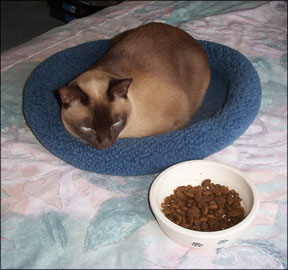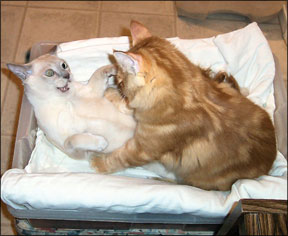288 When a cats food intake drops off, for whatever reason, the resulting decrease in protein intake can trigger feline hepatic lipidosis (FHL), the most common form of liver disease in cats. Inadequate protein mobilizes fat from the adipose tissue, and the fat then accumulates in the liver. “Its a vicious cycle,” says Ned Kuehn, DVM, MS, a veterinary internist with Michigan Veterinary Specialists in Southfield, Michigan. “When a cat decreases food intake, more fat accumulates, making the cat feel worse and eat even less. This makes the hepatic lipidosis get worse.” The cat becomes anorexic, and severe liver failure occurs, often in as little as a couple of weeks. “Ive seen it happen within a week,” says Dr. Kuehn. Some of the Causes A wide range of conditions can trigger FHL. “Forty percent of cases are due to environmental changes in the house,” says Dr. Kuehn, who is board-certified by the American College of Veterinary Internal Medicine. Triggers include vacations, moving, a new baby, workers in the home, divorce and kids leaving for college. “Cats become stressed and decrease their food intake,” says Dr. Kuehn. Illnesses such as diabetes mellitus, hyperthyroidism or cancer; traumatic injury; or the presence of a foreign body in the intestinal tract may also lead to FHL. Feeding a cat adult dog food can cause hepatic lipidosis, as can a sudden change in diet. “You cant starve a cat into eating a new food if the cat doesnt like it,” says Dr. Kuehn. A cat may need a special diet to manage a disease, but if the cat refuses to eat it, he or she may develop FHL. “Watch your cat closely if youve changed his diet to make sure that he or she eats the new food,” says Dr. Kuehn. “One of the worst things you can do is to try to change a cats diet when the cat is not feeling well.” Many, but not all, cats that acquire FHL are obese, but not every fat cat develops fatty liver disease. Cats of any sex, breed or age can be affected, but most cats with FHL are middle-aged adults. Keeping your cat from becoming obese will diminish his chances of acquiring hepatic lipidosis, so feed him appropriate quantities of food and help him exercise to keep from adding extra pounds. “In keeping the cat lean, its all an issue of calories in and calories out,” says Dr. Kuehn. “If you feed too much, the cat will be obese, and once fat is on, the body does everything to keep it on.” Some Solutions 288 If your cat is diagnosed with feline hepatic lipidosis, intensive veterinary care will be necessary to get him through the initial crisis. Expect a five- to 14-day hospital stay. Most cats require feeding through a tube placed into the stomach or esophagus while the cat is anesthetized. Twelve hours after the tube is in place, feeding begins as a continuous trickle, then is gradually increased until the cat is fed a set amount of food through the tube at intervals. “You must get nutrition going,” says Dr. Kuehn. While your cat is in the hospital, your veterinarian may also give her intravenous fluids in addition to other medications. After a cat is released from the hospital, tube feeding will continue at home for an average of eight weeks. “The tube is easy to manage, and cats dont seem to care,” says Dr. Kuehn. Your veterinarian will prescribe a food with high caloric density that can be administered through the tube. “Once cats nibble on food on their own, we can cut back on tube feedings,” says Dr. Kuehn, “but we keep the tube inserted for two weeks after they finish the tube feedings to make sure they are maintaining their weight.” Although it is rare to have relapses of feline hepatic lipidosis, what triggered it the first time may trigger it again, so monitor your cats behavior and what he eats on an ongoing basis. 



